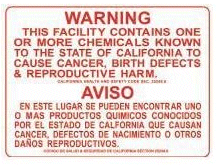I think I have presented enough justification to throw out Gradient's "Intake of metals in laundered shop towels via hand contact" equation:
 |
 |
| Guideline for Hand-to-Mouth Transfer of Lead through Exposure to Consumer Products: 2011 |
I commented on how close the CalEPA method intake values match the values I calculated when the Hand to Mouth transfer efficiency (HTE) rate was changed to a more appropriate 6% for an adult. But that comparison I made is like comparing apples with oranges.
The CalEPA intake is based on a single uptake event and is used as a threshold to meet the California Proposition 65 "Safe Harbor" designation.
A business has “safe harbor” from Proposition 65 warning requirements or discharge prohibitions if exposure to a chemical occurs at or below these levels. These safe harbor numbers consist of no significant risk levels (NSRL) for chemicals listed as causing cancer and maximum allowable dose levels (MADL) for chemicals listed as causing birth defects or other reproductive harm. (1)As long as a business can keep the exposure below the NSRL or MADL (whichever is lowest) the business does nor have to post Proposition 65 warnings. The assumption here is that below these levels there would be little risk for cancer or reproductive/birth defects. What it does not imply is that above those values there is risk. Risk is related to dose, the lower the dose, the lower the risk. NSRLs and MADL attempt to draw a line in the sand - one side is "no risk" and the other side is some.
The problem with the Prop 65 notice is that it does not communicate a degree of risk, only that there is risk. One cancer in 99,998 or one cancer in 98 gets the same warning:
Gradient assumes that laundered shop towels that contain concentrations of metals above these thresholds represent risk to the worker, hence the black and red bar graphic I showed in the first post on this topic:
 |
| Source |
A bit confusing for it shows copper as having a higher exceedance than lead. Anyway, it is based on information from this table:
 |
| 2011 Gradient Study |
Ignore the maximum intakes they reported - they are statistically impossible to reproduce in a real world situation (see post). Look instead at the average (mean) intake value for lead, which is the metal that presents the highest exceedance ratio compared to a threshold.
Using the intake equation Gradient developed for hand to mouth exposure, Gradient reports exceeding the CalEPA MADL and NSRL for lead for average laundered shop towel usage by a worker.
Using the CalEPA equation and the same average towel usage and average lead metal loading used by Gradient, I calculate the following exceedance "ratios" for lead:
This would generate an "exceedance ratio" of:
- MADL = 309 x
- NSRL = 10 x
Let's look at the "maximum allowable dose levels (MADL) for chemicals listed as causing birth defects or other reproductive harm." Here is what the CalEPA based the lead "safe harbor" MADL on:
 |
| CalEPA 2008 Page 13 |
That "safe" value of 0.0000071 mg/kg-day is based on fetal development, which is only applicable to a female worker who is pregnant and using the laundered shop towels. That "safe" threshold - MADL - is not applicable to a male worker's intake using the same laundered shop towels.
Let's look a bit closer on how that MADL for lead is calculated.
The MADL is the level at which chemicals listed for reproductive toxicity would have no observable effect assuming exposure at 1,000 times that level. (3)What is the " no observable effect" level?
No-observed-adverse-effect level (NOAEL): The highest tested dose of a substance that has been reported to have no harmful (adverse) health effects on people or animals. (4)
No-Observed-Adverse-Effect Level (NOAEL)—The dose of a chemical at which there were no statistically or biologically significant increases in frequency or severity of adverse effects seen between the exposed population and its appropriate control. Effects may be produced at this dose, but they are not considered to be adverse. (5: Page 526)Neither ASTDR nor IRIS identify a NOAEL for lead, instead they use a blood lead level as a "safe" dose.
So if we assume that the lead MADL is based on an effect to the fetus, and we assume that the lead MADL of 0.5 ug-day is 1000 times lower than the NOAEL, the NOAEL used by CalEPA must be 500 ug-day (0.5 x 1000 = 500). I can find nothing on how CalEPA derived the value "0.5 ug-day" other than this and this.
A NOAEL of 500 ug-day is equal to 7.14 ug/kg-day or 0.007 mg/kg-day (based on 70 kg body weight). 0.007 = 7.0E-03
Gradient reported an average "typical use" intake for lead of 4.2E-03 (Table 8 Page 13). Even using all of Gradient's assumptions and their intake formula, the intake they report is below the No-observed-adverse-effect level used by CalEPA (7.0E-03). An average use of 12 towels per day for five days a week, for 245 days per year for 40 years falls below the lowest concentration reported to show no adverse effects.
Still not convinced that these laundered shop towels pose no increase of risk to a worker, even a pregnant one exposed to a mean concentration of lead at 100 ppm? Well, let's look at it another way.
What is the amount of lead in soil that would be considered to present a risk for a person who ingests 50 mg of soil each day for a total of 219 days in a year?
In other words, under certain assumptions, what would the clean-up level for the lead in the soil be?
Next post: Laundered Shop Towels: 11 - Lead, a fetus, and a PPM.
.

No comments:
Post a Comment